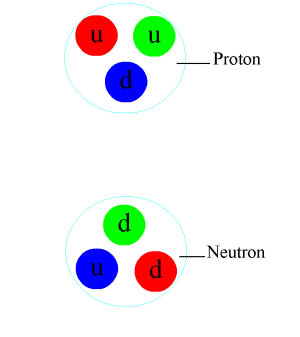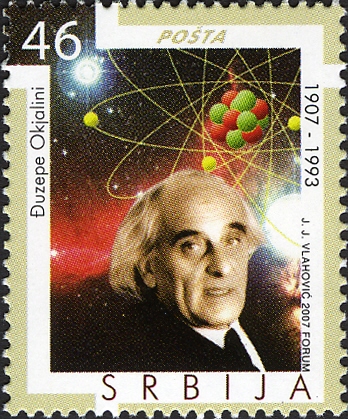|
Pion
In particle physics, a pion (, ) or pi meson, denoted with the Greek alphabet, Greek letter pi (letter), pi (), is any of three subatomic particles: , , and . Each pion consists of a quark and an antiquark and is therefore a meson. Pions are the lightest mesons and, more generally, the lightest hadrons. They are unstable, with the charged pions and decaying after a mean lifetime of 26.033 nanoseconds ( seconds), and the neutral pion decaying after a much shorter lifetime of 85 attoseconds ( seconds). Charged pions most often particle decay, decay into muons and muon neutrinos, while neutral pions generally decay into gamma rays. The exchange of virtual particle, virtual pions, along with vector meson, vector, rho meson, rho and omega mesons, provides an explanation for the nuclear force, residual strong force between nucleons. Pions are not produced in radioactive decay, but commonly are in high-energy collisions between hadrons. Pions also result from some ... [...More Info...] [...Related Items...] OR: [Wikipedia] [Google] [Baidu] |
Meson
In particle physics, a meson () is a type of hadronic subatomic particle composed of an equal number of quarks and antiquarks, usually one of each, bound together by the strong interaction. Because mesons are composed of quark subparticles, they have a meaningful physical size, a diameter of roughly one femtometre (10 m), which is about 0.6 times the size of a proton or neutron. All mesons are unstable, with the longest-lived lasting for only a few tenths of a nanosecond. Heavier mesons decay to lighter mesons and ultimately to stable electrons, neutrinos and photons. Outside the nucleus, mesons appear in nature only as short-lived products of very high-energy collisions between particles made of quarks, such as cosmic rays (high-energy protons and neutrons) and baryonic matter. Mesons are routinely produced artificially in cyclotrons or other particle accelerators in the collisions of protons, antiprotons, or other particles. Higher-energy (more massive) mesons were ... [...More Info...] [...Related Items...] OR: [Wikipedia] [Google] [Baidu] |
César Lattes
Cesare Mansueto Giulio Lattes (11 July 1924 – 8 March 2005), also known as César Lattes, was a Brazilian experimental physicist, one of the discoverers of the pion, a composite subatomic particle made of a quark and an antiquark. Life Lattes was born to a family of Italian immigrants in Curitiba, Paraná, Brazil. He began his basic studies at his home state but later on moved to São Paulo, where he finished high school. He proceeded to enroll in the University of São Paulo, graduating in 1943, in mathematics and physics. He was part of an initial group of young Brazilian physicists who worked under European teachers such as Gleb Wataghin and Giuseppe Occhialini. Lattes was considered the most brilliant student in his group and was noted at a very young age as a bold researcher. His colleagues, who also became important Brazilian scientists, were Oscar Sala, Mário Schenberg, Roberto Salmeron, Marcelo Damy de Souza Santos and Jayme Tiomno. At the age of 25, he was ... [...More Info...] [...Related Items...] OR: [Wikipedia] [Google] [Baidu] |
Rho Meson
In particle physics, a rho meson is a short-lived hadronic particle that is an isospin triplet whose three states are denoted as , and . Along with pions and omega mesons, the rho meson carries the nuclear force within the atomic nucleus. After the pions and kaons, the rho mesons are the lightest strongly interacting particle, with a mass of for all three states.There should be a small mass difference between the and the that can be attributed to the electromagnetic self-energy of the particle as well as a small effect due to isospin breaking arising from the light quark masses; however, the current experimental limit is that this mass difference is less than . The rho mesons have a very short lifetime and their decay width is about with the peculiar feature that the decay widths are not described by a Breit–Wigner form. The principal decay route of the rho mesons is to a pair of pions with a branching rate of 99.9%.Neutral rho mesons can decay to a pair of electrons ... [...More Info...] [...Related Items...] OR: [Wikipedia] [Google] [Baidu] |
Gamma Ray
A gamma ray, also known as gamma radiation (symbol ), is a penetrating form of electromagnetic radiation arising from high energy interactions like the radioactive decay of atomic nuclei or astronomical events like solar flares. It consists of the shortest wavelength electromagnetic waves, typically shorter than those of X-rays. With frequencies above 30 exahertz () and wavelengths less than 10 picometers (), gamma ray photons have the highest photon energy of any form of electromagnetic radiation. Paul Villard, a French chemist and physicist, discovered gamma radiation in 1900 while studying radiation emitted by radium. In 1903, Ernest Rutherford named this radiation ''gamma rays'' based on their relatively strong penetration of matter; in 1900, he had already named two less penetrating types of decay radiation (discovered by Henri Becquerel) alpha rays and beta rays in ascending order of penetrating power. Gamma rays from radioactive decay are in the energy range ... [...More Info...] [...Related Items...] OR: [Wikipedia] [Google] [Baidu] |
Weak Interaction
In nuclear physics and particle physics, the weak interaction, weak force or the weak nuclear force, is one of the four known fundamental interactions, with the others being electromagnetism, the strong interaction, and gravitation. It is the mechanism of interaction between subatomic particles that is responsible for the radioactive decay of atoms: The weak interaction participates in nuclear fission and nuclear fusion. The theory describing its behaviour and effects is sometimes called quantum flavordynamics (QFD); however, the term QFD is rarely used, because the weak force is better understood by Electroweak interaction, electroweak theory (EWT). The effective range of the weak force is limited to subatomic distances and is less than the diameter of a proton. Background The Standard Model of particle physics provides a uniform framework for understanding electromagnetic, weak, and strong interactions. An interaction occurs when two particles (typically, but not necess ... [...More Info...] [...Related Items...] OR: [Wikipedia] [Google] [Baidu] |
Giuseppe Occhialini
Giuseppe Paolo Stanislao "Beppo" Occhialini ForMemRS (; 5 December 1907 – 30 December 1993) was an Italian physicist who contributed to the discovery of the pion or pi-meson decay in 1947 with César Lattes and Cecil Frank Powell, the latter winning the Nobel Prize in Physics for this work. At the time of this discovery, they were all working at the H. H. Wills Laboratory of the University of Bristol. The X-ray satellite SAX was named BeppoSAX in his honour after its launch in 1996. Biography His father was the physicist Raffaele Augusto Occhialini (1878–1951), a pioneer in the fields of spectroscopy and electronics theory. Giuseppe Paolo Stanislao Occhialini graduated at Florence in 1929. In 1932, he collaborated in the discovery of the positron in cosmic rays at the Cavendish Laboratory of Cambridge, under the leadership of Patrick Blackett, using cloud chambers. He returned in Italy in 1934, where he suffered from the political climate generated by fascism. Thus, ... [...More Info...] [...Related Items...] OR: [Wikipedia] [Google] [Baidu] |
Muon
A muon ( ; from the Greek letter mu (μ) used to represent it) is an elementary particle similar to the electron, with an electric charge of −1 '' e'' and a spin of ''ħ'', but with a much greater mass. It is classified as a lepton. As with other leptons, the muon is not thought to be composed of any simpler particles. The muon is an unstable subatomic particle with a mean lifetime of , much longer than many other subatomic particles. As with the decay of the free neutron (with a lifetime around 15 minutes), muon decay is slow (by subatomic standards) because the decay is mediated only by the weak interaction (rather than the more powerful strong interaction or electromagnetic interaction), and because the mass difference between the muon and the set of its decay products is small, providing few kinetic degrees of freedom for decay. Muon decay almost always produces at least three particles, which must include an electron of the same charge as the muon and t ... [...More Info...] [...Related Items...] OR: [Wikipedia] [Google] [Baidu] |
Cecil Powell
Cecil Frank Powell (5 December 1903 – 9 August 1969) was an English particle physicist who received the Nobel Prize in Physics in 1950 for heading the team that developed the photographic method of studying nuclear processes and for the resulting discovery of the pion (pi-meson), a subatomic particle. Personal life Powell was born in Tonbridge, Kent, England, the son of Frank (a gunsmith) and Elizabeth Caroline (née Bisacre) Powell. He was educated at a local primary school before gaining a scholarship to the Judd School, Tonbridge. Following this, he attended Sidney Sussex College, Cambridge, graduating in 1925 in natural sciences. After completing his bachelor's degree, he worked at the Cavendish Laboratory, Cambridge, under C.T.R. Wilson and Lord Rutherford, conducting research into condensation phenomena, and gaining his PhD in physics in 1927. In 1932, Powell married Isobel Artner (1907–1995). They had two daughters, Jane and Annie. Professional life In 1928 he ... [...More Info...] [...Related Items...] OR: [Wikipedia] [Google] [Baidu] |
Antiquark
A quark () is a type of elementary particle and a fundamental constituent of matter. Quarks combine to form composite particles called hadrons, the most stable of which are protons and neutrons, the components of atomic nuclei. All commonly observable matter is composed of up quarks, down quarks and electrons. Owing to a phenomenon known as '' color confinement'', quarks are never found in isolation; they can be found only within hadrons, which include baryons (such as protons and neutrons) and mesons, or in quark–gluon plasmas. There is also the theoretical possibility of more exotic phases of quark matter. For this reason, much of what is known about quarks has been drawn from observations of hadrons. Quarks have various intrinsic properties, including electric charge, mass, color charge, and spin. They are the only elementary particles in the Standard Model of particle physics to experience all four fundamental interactions, also known as ''fundamental forces'' (ele ... [...More Info...] [...Related Items...] OR: [Wikipedia] [Google] [Baidu] |
Subatomic Particle
In physics, a subatomic particle is a particle smaller than an atom. According to the Standard Model of particle physics, a subatomic particle can be either a composite particle, which is composed of other particles (for example, a baryon, like a proton or a neutron, composed of three quarks; or a meson, composed of two quarks), or an elementary particle, which is not composed of other particles (for example, quarks; or electrons, muons, and tau particles, which are called leptons). Particle physics and nuclear physics study these particles and how they interact. Most force-carrying particles like photons or gluons are called bosons and, although they have quanta of energy, do not have rest mass or discrete diameters (other than pure energy wavelength) and are unlike the former particles that have rest mass and cannot overlap or combine which are called fermions. The W and Z bosons, however, are an exception to this rule and have relatively large rest masses at approxim ... [...More Info...] [...Related Items...] OR: [Wikipedia] [Google] [Baidu] |



